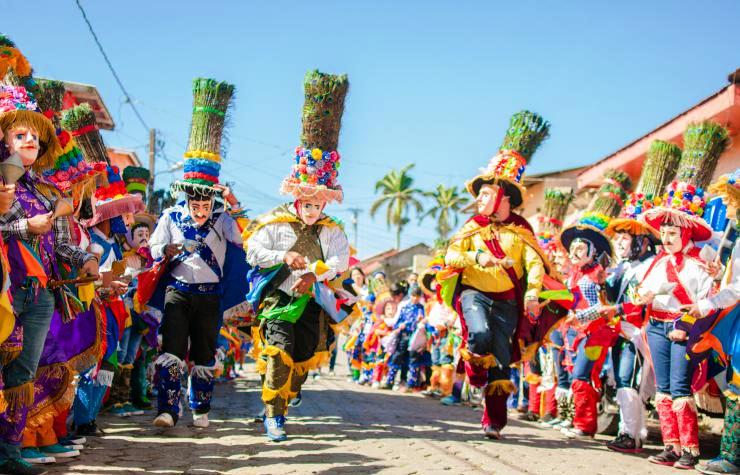A Nicaraguan mask play that defies the arrogance of the powerful with style and creativity. An extraordinary portrait of non-violent resistance. It is an essential part of Nicaraguan culture.
The January wind cuts a path through the peaceful town of Diriamba, 45Km from the capital Managua. Diriamba owes its name to Cacique Diriangen, the legendary Nahuati Indian chief.
On 19 January people come from all over the country to celebrate the feast of the city patron, San Sebastián (St Sebastian). Thousands take to the streets of Diriamba to accompany their saint to the meeting (tope) with the other saints of the nearby towns: Santiago (Jinitepe), San Marco (St Mark) and the Dolores (Our Lady of Sorrows).
Accompanying San Sebastián there is a group of people all wearing a mask typical of the Diriamba culture, the Güegüense. Also known as Macho Raton, the Güegüense is a satirical drama and a synthesis of the American Indian culture and that of Spain. It is a combination of drama, music, and dance and it is also the name of the main character of the drama. There are various versions of this theatrical work for a total of 314 stories centred upon the conflict between the Spanish colonial authorities and the Indians of America.
The Güegüense (a name that in the American Indian language Nahuati refers to an old and powerful personality of pre-Hispanic Nicaragua) defends himself by means of clever verbal devices against the accusations levelled at him by the colonial authorities.
He does not challenge the authority and neither does he seek to directly answer the accusations but uses every possible device to undermine Spanish authority. Unlike the carnival in other cities that lasts only one day, the festival of Diriamba lasts a full week.
The theatrical presentation is carried out within the city with processions in the streets and public dances. Musical accompaniment is provided by violins, guitars, and drums; the various characters are distinguished by their costumes, wooden masks, hair-dos, and other accessories.
The main characters with a role in the various stories are Güegüense, his children, the Spanish authorities, and some mythical animals. Güegüense ought to be a respectable elder but is depicted here as a rascal, at least with regard to the Spanish conquistadors. His comments are cynical, he is pretentious and full of deceit. The actor playing this role wears a mask, in itself a sign that he does not wish to reveal his true identity. Don Forcico and Don Ambrosio, the two sons of Güegüense, do not appear to be brothers.
Forcico is a villain who approves of the tricks and lies of his father. Ambrosio is honest and tries to unmask the dishonesty of his father. Sometimes Suchi Malinche appears in the plays. She is the daughter of the governor. Her name comes from a Nahuati word meaning flower and from the name Malinche, the name of the Indian girl who was Cortes’ interpreter during his first Mexican campaign, afterwards becoming his lover. At the end of the play, two horses (or mules) appear surmounted by goat horns and framed by wicker baskets decked with ribbons.
There is a relationship between the symbols to be found in the local superstitions and the horse (mule) that arrived in Nicaragua with the Spanish conquest. They represent both a warning to understand the false accusations and the new elements that might be used for the benefit of the local population.
Many stories reach the royal Council within the palace of the governor. Güegüense is accused of something illegal, usually of having entered the province without permission. Utilising many promises and assurances, the old fox succeeds not only in avoiding punishment but even receives a substantial reward, usually a marriage between his son and the daughter of the governor. The language used is a mixture of old Spanish and Nahuati.
At first, this vernacular was used as a means of communication between the conquistadors and their subjects but then came into common use among the Spanish who lived in Central America. True Aztecs speak with disdain of this dialect as the language of the slaves. This language was used by Güegüense to his advantage. Pretending not to understand, he avoids direct questions, answers in ways unconnected with the questions put to him and distorts everything in a comical way. Nobody knows for certain when this play was composed. Some indications refer to the arrival of Captain Fernandez Davila (1522 ca). Davila met the local tribe whose chief was Diriangen.
The indigenous people received the foreigners courteously and listened to their requests, but the Spanish decimated the Diriangen tribe and the survivors were subjected to Spanish rule.
Perhaps only a hundred years later, some of the descendants of these survivors managed to create a theatrical representation that showed peaceful resistance to the foreign rulers. Acted out under the very noses of the conquistadors, the play makes fun of them and their inability to truly conquer the spirit of the local population.
Güegüense is a work that is full of life and expresses the resistance of a nation against foreign invasion and makes up one of the most important cultural patrimonies of the Nicaraguan population. It was for this reason that, in 2005, UNESCO recognised Güegüense worldwide and proclaimed it a world heritage. It is an extraordinary portrait of non-violent resistance against a more powerful enemy and, at the same time, testimony to the creativity of the Nicaraguan people. (Pedro Santacruz) – (Photo: Julio Molina)






